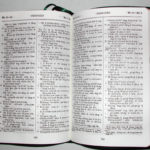There are a lot of interesting facts about the Bible, but here are 10 interesting facts about the Bible’s translation.
Multiple Translations
When an average person thinks about the Bible translation, the most common question relates to the accuracy of how each term has been interpreted or whether the original word order has been preserved, yet it must be made clear from the start that every translation of the Holy Scriptures is not only grammatical excellence or knowledge of an ancient language, but also the readiness of a person to let the Holy Spirit show him or her the way towards an accurate interpretation. Considering the fact that the Bible has been translated into at least 670 languages, and the New Testament’s availability in 1,521 languages, it’s important to know how the translations took place, while learning some interesting facts about them. It will not only help to discover something unusual but will help us appreciate the fact that the Bible translation we have now is genuine and accurate.
10 Facts About The Bible
It’s hard to find an example of such a complex translation history as you will with the Bible, but there are certain standard that must be followed in translating the Bible. [1]
[1]
Literal Translations
Literal translations are hard to interpret. As a rule, some versions present a word-for-word interpretation, yet it makes it very difficult to read because even if we take a Greek or a Latin Bible source, it is nearly impossible to translate some words into the English language word-for-word and to fully transpose the literal meaning that will be normal reading because it comes from a complex language like Greek.
Original Languages
The original Bible was written in three distinct languages. These are Hebrew for the most part, Aramaic, and Greek, however, the majority of the Old Testament as we know it today was written in Hebrew. It can be considered as an original language of the Bible. Now Ezra and Daniel contain Aramaic elements that are far more complex than trying to understand or translate the Hebrew. As for the New Testament, we encounter the Greek language, which can be explained by the commonly used language of the times.
Easier Translation Method
Some translations of the Holy Bible took a different way by focusing on the idea-per-idea method, which makes it easier to explain God’s Word without using too many complex words or focusing on the grammatical aspect of an original text. Nevertheless, it is often used all over the world as a way to let young people understand the Bible with the help of the simpler terms, and give them increased accessibility by rightfully transposing all the important ideas.
Balance of Accessibility and Literal Meaning
A good example is the English Standard Version (ESV). Up to this day, it remains one of the most accurate and clear Bible mainstream versions that have been weighed against the Hebrew, Greek, and Aramaic. This eliminates the under-translation or missing any important nuances in the ESV. All archaic elements have been made easily accessible for modern day readers.
Gender-Neutral Translations
The English Standard Version or New Revised Standard Version (1989) are examples of gender-neutral translations. The reasons for such versions vary depending on each case, yet translators of the original Hebrew or Aramaic often claim that the gender specified is often related to the situation or a speaker. For example, Matthew 4:4 says “Man shall not live by bread alone, but by every word that comes from the mouth of God.”
Jewish Bible Translations
These particular versions like JPS or NJPS cannot be considered as simple English and there are solid reasons why most Jewish translations present both English and original Hebrew on facing pages. A controversial aspect of this Bible is that these translations follow Jewish opinions and even visions.
The Middle English Bible
This translation date back to the 14th century and revolves around the work of John Wycliffe. As an important predecessor to Protestantism, Wycliffe’s efforts were always opposed by the Roman Catholic Church, nevertheless, the legacy of this first translation cannot be underestimated since it paved the way for the Authorized King James Version Bible.
Different Word Count
The original Hebrew Bible contains about 611,000 words, yet it will not be the same with any English, Spanish, or even Greek version of the Bible. One reason for that is because any translator will have to use more words to bring out an original language point. Every language will use several words for a common Hebrew expression that cannot fit in one English word alone. Moreover, in most cases, the Bible translations also aim for accuracy, so it often involves lengthy explanations. Even if the task is to provide a literal translation, it still ends up with more text due to the rules of the target language.
The Most Translated Book
While this is not new, an important part of the Bible being the most translated book in the world is that almost none of the modern people have skills or knowledge to read anything but a translation of it. Only scholars can approach such a task with accuracy. Even when learning Greek or Hebrew, and reading into the word order, a lot of literal meaning can easily be different from what the author had in mind. Fortunately, the Spirit will almost always guide a reader to a correct conclusion. [3]
[3]
The Stylistical Differences
The Bible has a wide variety of styles. It is not widely known, but translators of the Bible always face lexical peculiarities between the books because the Bible was written by representatives of various social or occupational backgrounds. For example, a fisherman used the words or a language style that was more common to his social circle, while the royalty representative was more cryptic. These differences are mostly noted by the religious scholars, yet it is still an important aspect of translation and a reminder that the Holy Spirit connects all kinds of people and guides them through even the most challenging tasks.
Conclusion
Always remember that no matter what translation might be taken as a reference, and regardless of one of the forty known author’s occupations, the Bible has been written under the direction of the Holy Spirit. The translators may have been helped by the Holy Spirit, but He will help you understand Scripture. Jesus said, “when the Helper comes, whom I will send to you from the Father, the Spirit of truth, who proceeds from the Father, he will bear witness about me” (John 15:236), and I don’t know about you, but I need all the help I can get to understand God’s Word. The Spirit is our greatest Help in this endeavor.
Here is some related reading for you: Five Tips for Picking the Best Bible Translation [4]
Resource – Scripture quotations are from The Holy Bible, English Standard Version® (ESV®), Crossway Bibles. (2007). ESV: Study Bible: English standard version. Wheaton, Ill: Crossway Bibles. Used by permission. All rights reserved.
Author’s Bio: As a devoted Christian and a part of the Word Point [5] translator’s team, Mark Blackwood works hard to make knowledge available to people regardless of the language they speak. His posts are always kind and accessible to anyone as he writes about education or technology. Follow Mark to learn something new daily!


